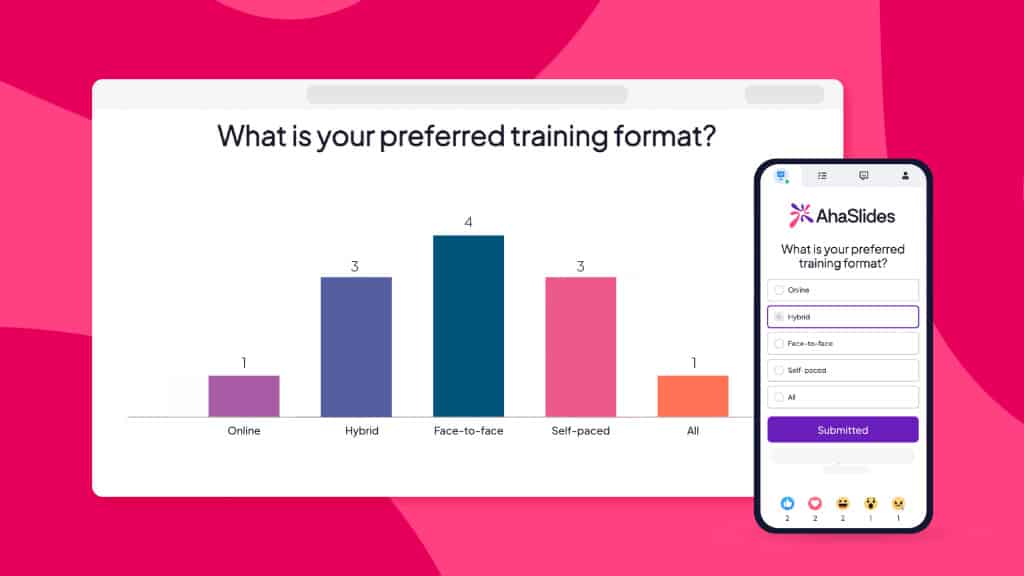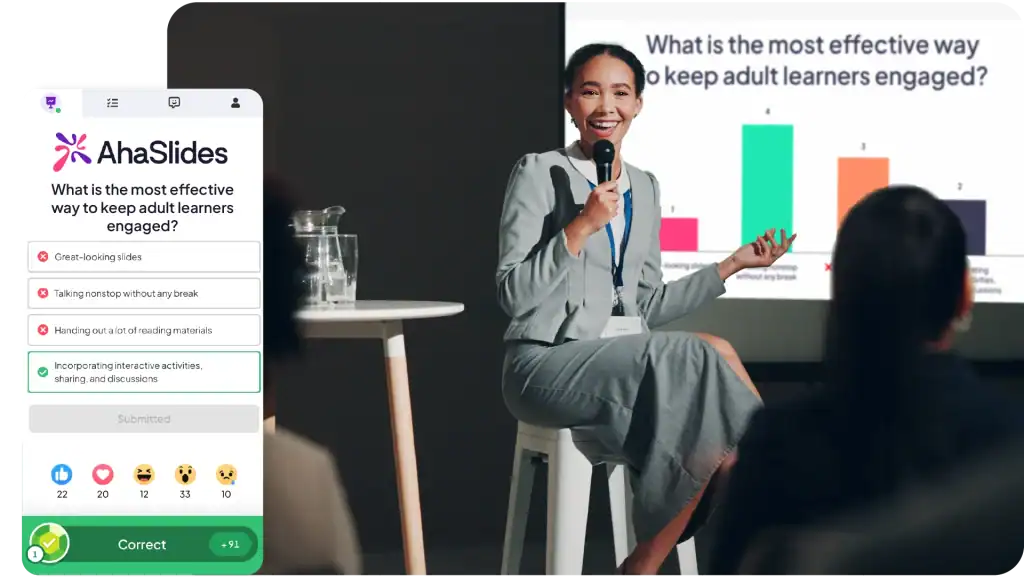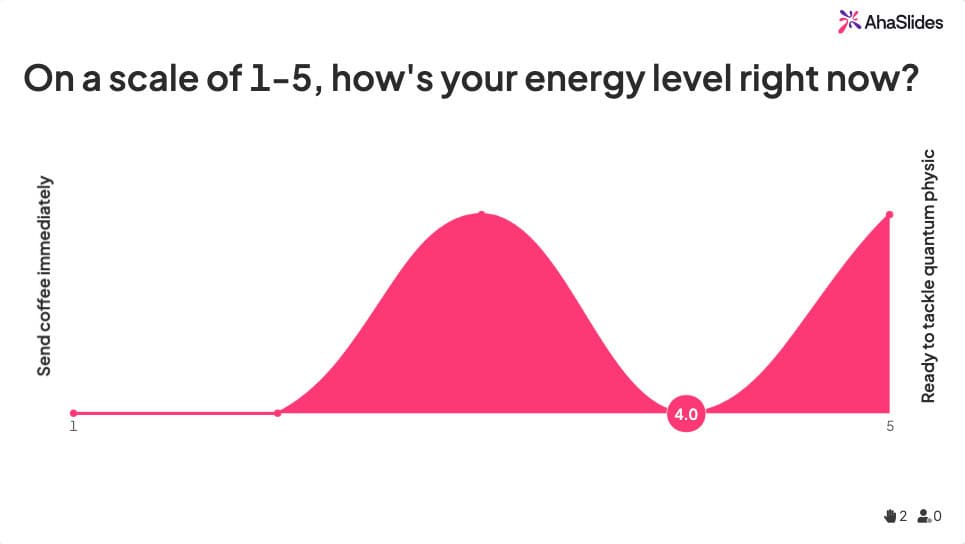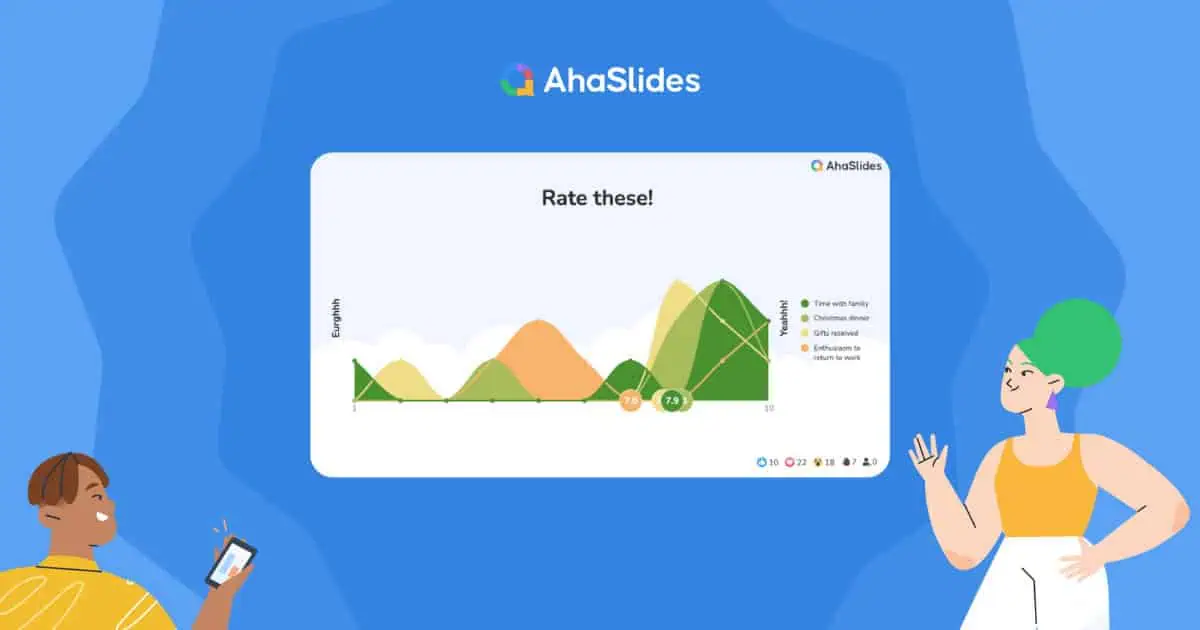Yn economi sylw sydd wedi'i hyfforddi gan TikTok heddiw, mae gennych chi tua 8 eiliad i ddal diddordeb rhywun—llai o amser na physgodyn aur. Os yw hynny'n swnio'n frawychus ar gyfer cyflwyniad 5 munud, dyma'r newyddion da: cyflwyniadau byr yw eich arf cyfrinachol.
Tra bod eraill yn crwydro drwy ddeciau 60 sleid gan wylio llygaid yn pylu, byddwch chi'n cyfleu neges ffocws sy'n glynu. P'un a ydych chi'n cyflwyno i fuddsoddwyr, yn hyfforddi tîm o bell, yn cyflwyno canfyddiadau ymchwil, neu'n cael cyfweliad ar gyfer eich rôl ddelfrydol, nid yn unig yw meistroli'r fformat 5 munud yn gyfleus - mae'n diffinio gyrfa.
Mae'r canllaw hwn yn tynnu ar wyddoniaeth cyflwyno, mewnwelediadau gan hyfforddwyr proffesiynol sy'n cyflwyno cannoedd o sesiynau bob blwyddyn, a thechnegau profedig gan siaradwyr TED i'ch helpu i greu cyflwyniadau sy'n ennyn diddordeb, yn perswadio, ac yn gadael effaith barhaol.
Tabl Cynnwys
Pam mae Cyflwyniadau 5 Munud yn Gofyn am Ddull Gwahanol
Ymchwil gan y niwrowyddonydd John Medina yn dangos bod sylw'r gynulleidfa'n gostwng yn sylweddol bob 10 munud yn ystod cyflwyniadau traddodiadol. Mewn lleoliadau rhithwir, mae'r ffenestr honno'n crebachu i ddim ond 4 munud. Mae eich cyflwyniad 5 munud yn eistedd yn berffaith o fewn y man ymgysylltu melys hwn—ond dim ond os ydych chi'n ei gynllunio'n gywir.
Mae'r risgiau'n uwch gyda chyflwyniadau byr. Mae pob gair yn cyfrif. Mae pob sleid yn bwysig. Does dim amser i lenwad, dim lle i bethau i fynd heibio, a dim goddefgarwch i gamgymeriadau technegol. Mae ymchwil yn y diwydiant yn dangos bod 67% o weithwyr proffesiynol bellach yn well ganddynt gyflwyniadau cryno, ffocws dros rai hir—ac eto mae'r rhan fwyaf o gyflwynwyr yn dal i ymdrin ag anerchiadau byr fel fersiynau cryno o rai hir, sydd anaml yn gweithio.
Sut i Wneud Cyflwyniad 5 Munud
Cam 1: Dewiswch Eich Pwnc Gyda Manwldeb Llawfeddygol

Y camgymeriad mwyaf mae cyflwynwyr yn ei wneud? Ceisio trafod gormod o dir. Dylai eich cyflwyniad 5 munud fynd i'r afael â un syniad craidd—nid tri, ddim hyd yn oed dau. Meddyliwch amdano fel laser, nid golau llifogydd.
Rhaid i'ch pwnc basio'r prawf pedair rhan hwn:
- Pwynt ffocws sengl: Allwch chi ei egluro mewn un frawddeg? Os na, cyfyngwch ar y pwnc.
- Perthnasedd cynulleidfa: A yw'n datrys problem maen nhw'n ei hwynebu'n weithredol? Hepgorwch wybodaeth maen nhw eisoes yn ei gwybod.
- Symlrwydd: Allwch chi ei egluro heb gefndir cymhleth? Cadwch bynciau cymhleth ar gyfer fformatau hirach.
- Eich arbenigedd: Daliwch ati i astudio pynciau rydych chi'n eu hadnabod yn ddwfn. Mae amser paratoi yn gyfyngedig.
Am ysbrydoliaeth, ystyriwch y pynciau 5 munud profedig hyn ar draws gwahanol gyd-destunau:
- Gosodiadau proffesiynol: 3 strategaeth sy'n seiliedig ar ddata i leihau trosiant cwsmeriaid, Sut mae offer AI yn ail-lunio ein llif gwaith, Pam mae ein canlyniadau Ch3 yn arwydd o newid strategol
- Hyfforddiant a Dysgu a Datblygu: Un arfer sy'n trawsnewid perfformiad tîm o bell, Y seicoleg y tu ôl i sgoriau ymgysylltu gweithwyr, Sut i roi adborth sy'n gwella ymddygiad mewn gwirionedd
- Cyd-destunau academaidd: Canfyddiadau allweddol o'm hymchwil cynaliadwyedd, Sut mae cyfryngau cymdeithasol yn effeithio ar wneud penderfyniadau ymhlith pobl ifanc, Moeseg golygu genynnau mewn tair senario go iawn
Cam 2: Dylunio Sleidiau Sy'n Ymhelaethu (Nid yn Tynnu Sylw)
Dyma wirionedd sy'n gwahanu cyflwynwyr amatur oddi wrth gyflwynwyr proffesiynol: chi yw'r cyflwyniad, nid eich sleidiau. Dylai sleidiau gefnogi eich naratif, nid ei ddisodli.
Y cwestiwn cyfrif sleidiau
Mae ymchwil gan arbenigwyr cyflwyno yn awgrymu 5-7 sleid ar gyfer sgwrs 5 munud—tua un sleid y funud gydag amser ar gyfer eich agoriad a'ch cloi. Fodd bynnag, mae siaradwyr TED weithiau'n defnyddio 20 sleid sy'n symud ymlaen yn gyflym (10-15 eiliad yr un) i gynnal momentwm gweledol. Yr hyn sy'n bwysicach na maint yw eglurder a phwrpas.
Egwyddorion dylunio cynnwys
- Testun lleiaf: Uchafswm o 6 gair fesul sleid. Dylai eich sgript 700 gair gael ei llefaru, nid ei harddangos.
- Hierarchaeth weledol: Defnyddiwch faint, lliw a gofod gwyn i gyfeirio sylw at yr hyn sydd bwysicaf.
- Delweddu data: Mae un ystadegyn neu graff cymhellol fesul sleid yn curo paragraffau o esboniad.
- Dyluniad cyson: Mae'r un ffontiau, lliwiau a chynlluniau drwyddi draw yn cynnal proffesiynoldeb.
Tip Pro: Gwnewch eich cyflwyniad yn rhyngweithiol gan ddefnyddio arolygon byw, nodweddion Holi ac Ateb, neu gwisiau cyflym. Mae hyn yn trawsnewid gwylwyr goddefol yn gyfranogwyr gweithredol ac yn gwella cadw gwybodaeth yn sylweddol. Offer fel AhaSlides yn gadael i chi fewnosod y nodweddion hyn yn ddi-dor, hyd yn oed mewn fformatau 5 munud.

Cam 3: Meistroli'r Amseru Gyda Manwl Gywirdeb Milwrol
Mewn cyflwyniad 5 munud, mae gan bob eiliad swydd. Does dim byffer ar gyfer crwydro na gwella o gamgymeriadau. Mae siaradwyr proffesiynol yn dilyn y strwythur profedig hwn:
Y fformiwla dyrannu amser brofedig
- 0:00-0:30 – Bachyn agoriadol: Denwch sylw gyda ffaith syfrdanol, cwestiwn pryfoclyd, neu stori gymhellol. Hepgorwch gyflwyniadau hir.
- 0:30-1:30 – Y broblem: Nodwch pam y dylai eich cynulleidfa ofalu. Pa her mae eich pwnc yn mynd i'r afael â hi?
- 1:30-4:30 – Eich ateb/mewnwelediad: Dyma eich cynnwys craidd. Cyflwynwch 2-3 pwynt allweddol gyda thystiolaeth ategol. Torrwch unrhyw beth diangen.
- 4:30-5:00 – Casgliad a galwad i weithredu: Atgyfnerthwch eich prif neges a dywedwch wrth y gynulleidfa yn union beth i'w wneud nesaf.
Addasiad cyflwyniad rhithwir
Cyflwyno o bell? Cynhwyswch foment ymgysylltu bob 4 munud (yn ôl ymchwil Medina). Defnyddiwch arolygon barn, gofynnwch am ymatebion sgwrsio, neu gofynnwch gwestiynau rhethregol. Gwiriwch ongl eich camera (lefel y llygad), sicrhewch oleuadau cryf o'r tu blaen, a phrofwch ansawdd y sain ymlaen llaw. Mae cynulleidfaoedd rhithwir yn fwy tueddol o gael eu tynnu sylw, felly nid yw rhyngweithio yn ddewisol—mae'n hanfodol.

Cam 4: Cyflwyno Gyda Hyder Dilys

Mae hyd yn oed cynnwys gwych yn methu â chyflwyniad gwael. Dyma sut mae gweithwyr proffesiynol yn mynd ati i gyrraedd y foment wirionedd:
Ymarferwch fel pe bai eich gyrfa'n dibynnu arno (oherwydd gallai)
Ymarferwch eich cyflwyniad 5 munud o leiaf 5-7 gwaith. Defnyddiwch amserydd. Recordiwch eich hun a'i wylio yn ôl—yn boenus ond yn amhrisiadwy. Ymarferwch nes y gallwch gyflwyno'ch cynnwys yn naturiol heb ddarllen sleidiau. Mae cof cyhyrau yn eich cario trwy nerfusrwydd.
Technegau cyflwyno sy'n gwahanu amaturiaid oddi wrth weithwyr proffesiynol
- Amrywiaeth lleisiol: Amrywiwch y cyflymder, y traw a'r cyfaint. Oedwch yn strategol i bwysleisio—mae distawrwydd yn bwerus.
- Iaith corfforol: Yn bersonol, defnyddiwch ystumiau agored a symudwch gyda phwrpas. Ar gamera, cyfyngwch ar ystumiau (maent yn ymhelaethu) a chadwch gyswllt llygad â'r lens.
- Adrodd straeon: Ychwanegwch enghraifft neu hanesyn byr, perthnasol. Mae straeon yn rhoi hwb i gadw pobl 22 gwaith o'i gymharu â ffeithiau yn unig.
- Rheoli ynni: Cydweddwch eich egni â'ch neges. Yn frwdfrydig am ysbrydoliaeth, yn fesuradwy ar gyfer pynciau difrifol.
- Parodrwydd technegol: Profwch offer 30 munud yn gynnar. Cael cynlluniau wrth gefn ar gyfer problemau cysylltedd.
Cyfrinach y cysylltiad â'r gynulleidfa
Meddyliwch am eich cyflwyniad fel sgwrs, nid perfformiad. Cadwch gyswllt llygad (neu edrychwch ar y camera ar gyfer cyflwyniadau rhithwir). Cydnabyddwch ymatebion. Os byddwch chi'n baglu, oedwch am ychydig a pharhewch—mae cynulleidfaoedd yn maddau i ddilysrwydd, ond nid i ddarllen sleidiau'n robotig.
Awgrym cyfrinachol: Ddim yn gwybod a yw eich cyflwyniad 5 munud yn gwneud argraff? Defnyddiwch offeryn adborth i gasglu teimlad y gynulleidfa ar unwaith. Mae'n cymryd ychydig iawn o ymdrech, ac rydych chi'n osgoi colli adborth gwerthfawr ar hyd y ffordd.

5 Camgymeriad Cyffredin Wrth Roi Cyflwyniad 5 Munud
Rydyn ni'n goresgyn ac yn addasu trwy brofi a methu, ond mae'n haws osgoi camgymeriadau rookie os ydych chi'n gwybod beth ydyn nhw👇
- Yn rhedeg dros amser: Mae cynulleidfaoedd yn sylwi. Mae'n arwydd o baratoi gwael ac yn amharchu eu hamserlen. Ymarferwch i orffen am 4:45.
- Gorlwytho sleidiau: Mae sleidiau llawn testun yn gwneud i gynulleidfaoedd ddarllen yn lle gwrando. Rydych chi'n colli eu sylw ar unwaith.
- Ymarfer sgipio: Mae "dim ond 5 munud ydyw" yn feddwl peryglus. Mae fformatau byr yn gofyn am MWY o ymarfer, nid llai.
- Yn ceisio gorchuddio popeth: Mae dyfnder yn drech na lled. Mae un mewnwelediad clir sy'n atseinio yn well na phum pwynt nad oes neb yn eu cofio.
- Anwybyddu eich cynulleidfa: Addaswch y cynnwys i'w diddordebau, lefel gwybodaeth ac anghenion. Ni fydd cyflwyniadau generig byth yn llwyddo.
Enghreifftiau Cyflwyniad 5-Munud
Astudiwch yr enghreifftiau hyn i weld egwyddorion ar waith:
William Kamkwamba: 'Sut wnes i Harneisio'r Gwynt'
Mae hyn yn TED Sgwrs fideo yn cyflwyno stori William Kamkwamba, dyfeisiwr o Malawi a adeiladodd felin wynt yn blentyn yn profi tlodi i bwmpio dŵr a chynhyrchu trydan i’w bentref. Llwyddodd adrodd straeon naturiol a syml Kamkwamba i swyno’r gynulleidfa, ac mae ei ddefnydd o seibiau byr i bobl chwerthin hefyd yn dechneg wych arall.
Susan V. Fisk: 'Pwysigrwydd Bod yn Gryno'
Mae hyn yn fideo hyfforddi yn cynnig awgrymiadau defnyddiol i wyddonwyr i strwythuro eu sgwrs i gyd-fynd â fformat y cyflwyniad “5 Munud Cyflym”, sydd hefyd yn cael ei esbonio mewn 5 munud. Os ydych chi'n bwriadu creu cyflwyniad cyflym “Sut-i”, edrychwch ar yr enghraifft hon.
Jonathan Bell: 'Sut i Greu Enw Brand Gwych'
Fel mae'r teitl yn awgrymu, bydd y siaradwr Jonathan Bell yn rhoi i chi cam-wrth-gam ar sut i greu enw brand parhaol. Mae'n cyrraedd y pwynt yn syth gyda'i bwnc ac yna'n ei rannu'n gydrannau llai. Enghraifft dda i ddysgu ohoni.
Anfoneb PACE: 'Cae 5 Munud yn Startupbootcamp'
Mae'r fideo hwn yn dangos sut Anfoneb PACE, cwmni newydd sy'n arbenigo mewn prosesu taliadau aml-arian, yn gallu cyflwyno ei syniadau i fuddsoddwyr yn glir ac yn gryno.
Will Stephen: 'Sut i Swnio'n Glyfar yn Eich Sgwrs TEDx'
Gan ddefnyddio dull doniol a chreadigol, Sgwrs TEDx gan Stephen yn arwain pobl trwy sgiliau cyffredinol siarad cyhoeddus. Rhaid gwylio i wneud eich cyflwyniad yn gampwaith.
Yn barod i greu cyflwyniadau sy'n denu sylw go iawn? Dechreuwch gydag offer cyflwyno rhyngweithiol AhaSlides a thrawsnewid eich cyflwyniad 5 munud nesaf o un anghofiadwy i un anghofiadwy.








